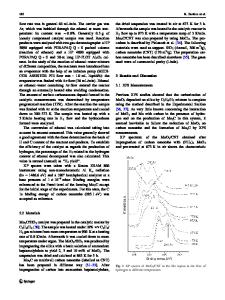N -alkyldithiocarbamato complexes [Cd(S 2 CNHR) 2 ] (R = C 2 H 5 , C 4 H 9 , C 6 H 13 , C 12 H 25 ); Synthesis, Characte
- PDF / 236,251 Bytes
- 6 Pages / 612 x 792 pts (letter) Page_size
- 48 Downloads / 376 Views
Z7.3.1
N-alkyldithiocarbamato complexes [Cd(S2CNHR)2] (R = C2H5, C4H9, C6H13, C12H25); Synthesis, Characterisation and Deposition of II/VI Nanoparticles. A. A. Memon,a M. A. Malik,b M. Afzaal,b P. O’Brienb* a
Department of Chemistry, Shah Abdul Latif University, Khairpur, Sindh, Pakistan.
b
School of Materials and School of Chemistry, The University of Manchester, Oxford Road, Manchester, M13 9PL, UK. E-mail: [email protected], [email protected] ABSTRACT A series of N-alkyldithiocarbamato complexes of cadmium have been synthesised and characterized. [Cd(S2CNHC12H25)2] complex was used as a single source precursor to synthesize CdS nanoparticles. Synthesis of CdS nanoparticles was carried out at various thermolysis temperatures and concentration of the precursor to observe the morphological changes. At moderate or high temperature the 1D nanostructures (single-rods, bend rods or multi-rods) are generated. The shape of CdS nanocrystals varied from longer rods to shorter rods with increased width (average size: 4nm wide and 27nm long vs. 9nm wide and 27nm long) by simply increasing the quantity of precursor in the bulk solution from 0.05g/8ml HDA to 1g/8ml HDA at 250 °C. INTRODUCTION Zinc and cadmium complexes [M(S2CNR2)2] (M = Zn or Cd, R = Alkyl) have been used as single source precursors to deposit ZnS or CdS thin films by metal-organic chemical vapour deposition (MOCVD)[1-4]. Numerous complexes of chalcogenide containing ligands have been studied as precursors for the deposition of group II/VI compound semiconductor materials [5-9]. Dithiocarbamato complexes are air-stable with reasonable volatility and give clean deposition with little carbon incorporation [10]. Thin films of cadmium and zinc sulfide can be prepared by MOCVD under low-pressure conditions using the bis-diethyldithiocarbamato complex of cadmium or zinc [4,11]. We used bis(diethyldithio/diselenocarbamato)cadmium(II) to synthesise CdS and CdSe nanoparticles [12]. Their crystal structures have been reported [13,14]. Both compounds have similar structures based on dimeric molecular units. These complexes have also been used to grow corresponding thin films by MOCVD method [13,15]. In an extension of the TOPO method devised by Murry et. al. [16-18] TOPO-capped CdS and CdSe nanoparticles were prepared using mixed alky compounds [MeCdE2CNEt2]2 (E = S, Se) [19]. Although high quality nanoparticles were synthesised using single source precursors of mixed alkyl derivatives but these compounds are air sensitive and cannot be stored for longer periods of times. Bis(diethyldithiocarbamato)cadmium compounds have the advantage of stability but the yield and the quality of nanoparticles was not good. However, we developed some novel air stable precursors based on bis(methy-n-hexyl-diselenocarbamato)zinc or cadmium which decompose cleanly in MOCVD to metal selenides.[20-22]. Bis(methyl-nhexyl)dithio/selenocarbamato)cadmium/zinc proved to be the best unsymmetrical derivatives for the growth of chalogenide materials [23]. Good quality monodisp
Data Loading...











